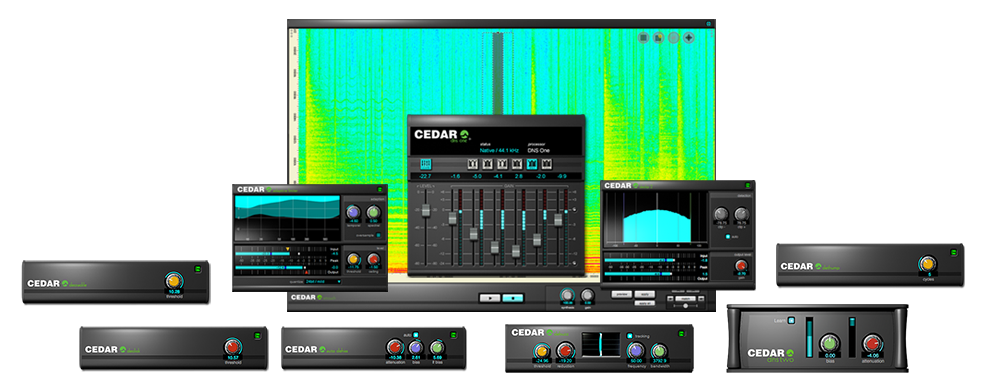
Containing all eleven processes from CEDAR Studio DNS™, CEDAR Studio Restore™ and CEDAR Studio Retouch™, CEDAR Studio Complete is the most advanced plug-in suite available for noise suppression and audio restoration. It will eliminate your impulsive noise problems – clicks, crackle, and thumps – remove background noise, reduce hiss, and eliminate hums, buzzes, and clipping distortion. It will also allow you to remove individual sounds, correct wrong notes, and much, much more. Finally, to prepare your track for its intended purpose, its unique Adaptive Limiter is ideal for mastering and maximising.
When the audio really matters, audio engineers rely upon CEDAR Studio Complete.
$8,006.00

Declick offers better impulsive noise detection and a better interpolator than any other plug-in declicker. This results in superior performance across a wider range of material than ever before. Indeed, this performance is so good that, in most cases, it’s not possible to hear that the signal was damaged prior to restoration.

Decrackle boasts a remarkable ability to dig into the damaged signal to identify and remove all manner of ground-in and grungy crackle without damaging the wanted audio. It also removes many forms of buzz and some amplitude distortions from material ranging from cylinder recordings to current broadcasts contaminated with lighting buzz.

Manual Declick is ideal for restoring the extended scratches and clicks encountered on many audio media – film, tape or disk, whether analogue or digital. Its unique dual algorithms – optimised for long clicks and scratches – will remove noises such as those found on optical soundtracks, as well as drop-outs and extended digital errors.

Dethump eliminates the extended low-frequency thumps that cannot be restored using conventional declicking processes and filters. It replaces the unwanted sound with restored low frequency audio and is the ideal tool for removing many of the previously intractible problems associated with optical soundtracks, cylinders, 78rpm discs, and even modern recordings when, for example, microphones and stands are bumped.

Auto Dehiss embodies an advanced algorithm that is far less susceptible to the unwanted side-effects sometimes called twittering, glugging, the ‘underwater sound’, and even ‘space monkeys’. In short, it’s able to determine the broadband noise content and remove it without the introduction of these unwanted artefacts. A manual mode is also offered for fine-tuning the results when wanted.

Debuzz quickly and easily removes all manner of buzzes and hums with fundamentals as high as 500Hz, and it can eliminate unwanted signal components across the entire audio spectrum. It will track wandering tones and, unlike traditional filters, can successfully restore the audio without unwanted side-effects such as limited bandwidth or the hollow sound introduced by comb filters.

Declip 2 effortlessly removes clipped samples and reconstructs the original signal, improving clarity, eliminating distortion, and restoring the original dynamic range of the damaged audio. Our latest algorithm even tracks the clipping amplitude so that material that has later been processed with dynamics packages can still be restored.introduced by comb filters.

Adaptive Limiter 2 employs another unique algorithm developed by CEDAR that constrains the peak level of the output while retaining the integrity of the input. The result is a perfectly controlled signal that remains much more natural than audio processed using other limiters. It is also an unsurpassed loudness maximiser and, with its advanced resampling and noise shaping capabilities, is ideal for mixing, final mastering and other creative duties.

The world’s standards for dialogue noise suppression in film and TV post, DNS One and DNS Two offer the Academy Award® winning noise suppression of the DNS1000 and its successors, but adds CEDAR’s unique LEARN capability that allows the processes to adapt continually to changes in the noise, even when the wanted signal is present. They make unusable interviews intelligible, save huge costs in ADR, and have rescued dialogue for countless movies. In the words of one member of the Academy of Motion Picture Arts and Sciences, DNS was “probably used on every major movie coming out of Hollywood in the past couple of years”, and can now be found on virtually all dubbing stages worldwide.

Nowadays, we take spectral editing for granted, but it’s a relatively recent invention, first seen in 2002 when CEDAR patented the underlying technology and announced the first version of Retouch. It’s not an exaggeration to say that it changed the mastering industry and, today, it’s quite likely that you have access to some form of spectral editing that’s manufactured under licence from CEDAR.
When it was introduced, Retouch was a huge leap forward in sound processing technology. Unlike conventional restoration tools, it provided a wide range of time/frequency editing (TFE™) capabilities, and allowed you to define the temporal and spectral content of the sound you wanted to remove. Nowadays, it allows you to mark and process complex areas in its spectrogram using the types of tools commonly found in powerful photographic and image manipulation software. This makes it possible to identify all manner of sounds and noises which can then be manipulated using any of the processing tools at your disposal.